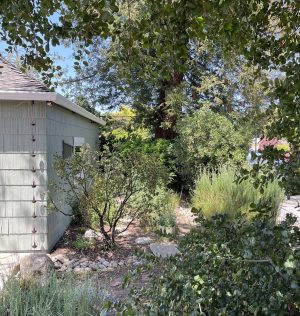Gardening for Wildlife
May 13, 2025

To create a bird-friendly yard, plant your garden with a bird’s diet in mind, choosing plants that nourish local Wildlife as well. Plant what birds like and what you like too, this creates biodiversity and a dynamic outdoor space to attract the widest variety of birds. Some people use the 70-30 rule (70% native plants; 30% other plants). Habitat loss due to development causes food and shelter for birds to disappear contributing to declines in migratory and resident songbirds. As natural spaces go away, your backyard can become an important wildlife refuge. Even small gardens, when planted thoughtfully, can provide the essentials birds need to survive: Food, Water, Shelter, and Safe Habitat.
Bird Habitat Essentials
Food–For a broader range of species, plant native trees, shrubs, and flowers to attract caterpillars and insects that birds eat. Offer high-quality seed in different feeders for seed-eaters.
Water–Birdbaths, fountains, or small ponds help birds drink and bathe. Moving water (like a bubbler or dripper) attracts even more birds.
Shelter–Birds need cover to stay safe from predators and weather. Trees, shrubs, dense grasses, leaf piles, and even vines or rock piles can serve as shelter.
Nesting Areas–Cavity-nesters like chickadees and bluebirds benefit from nesting boxes. Other birds like towhees may nest in shrubs. Some birds like juncos nest on the ground so ground cover is very important.
Gardening Tips to Support Wildlife
Plant native plants: These support native insects—an essential food source for birds, especially when raising young. If a yard is planted with at least 70% of native plants (and 30% decorative or tropical), birds should be able to find what they need.
Plant in layers: Combine tall trees, mid-sized shrubs, and low-growing plants to create natural structure.
Leave the leaf litter: Birds like sparrows and thrashers forage in it.
Avoid pesticides: Many birds rely on insects for food. By reducing chemicals, you protect them—and your family and pets.
Create “instant cover” in new yards: Use your discarded Christmas tree as a brush pile or add container gardens with nectar-rich flowers.
Once in bloom, keep the flowers and don’t hedge trim away.
Minimize hard pruning or tree trimming during the breeding season between March – August
Local Native Plant Resources
Yamagami’s Garden Center (Cupertino) – yamagamis.com Curious Flora Nursery (formerly Annie’s in Richmond) – curiousflora.com
CA Native Landscaping Professionals
Bay Maples: Wild CA Gardens – baymaples.com
California Nativescapes – calnativescapes.com
Smart Yards Coop – smartyardscoop.com/ourapproach
Together, we can make a difference for the birds by planting California native plants to support diet and habitat needs. Let’s support birdwatching, bird feeding, and bird health in our own yards. We invite you to visit us at the store for fresh bird seed, feeders, and more tips for creating a bird-friendly habitat.

To create a bird-friendly yard, plant your garden with a bird’s diet in mind. Plant what birds like and what you like too, this creates biodiversity and a dynamic outdoor space to attract the widest variety of birds. Some people use the 70-30 rule (70% native plants; 30% other plants). Habitat loss due to development causes food and shelter for birds to disappear contributing to declines in migratory and resident songbirds. As natural spaces go away, your backyard can become an important wildlife refuge. Even small gardens, when planted thoughtfully, can provide the essentials birds need to survive: Food, Water, Shelter, and Safe Habitat.
Bird Habitat Essentials
Food–For a broader range of species, plant native trees, shrubs, and flowers to attract caterpillars and insects that birds eat. Offer high-quality seed in different feeders for seed-eaters.
Water–Birdbaths, fountains, or small ponds help birds drink and bathe. Moving water (like a bubbler or dripper) attracts even more birds.
Shelter–Birds need cover to stay safe from predators and weather. Trees, shrubs, dense grasses, leaf piles, and even vines or rock piles can serve as shelter.
Nesting Areas–Cavity-nesters like chickadees and bluebirds benefit from nesting boxes. Other birds like towhees may nest in shrubs. Some birds like juncos nest on the ground so ground cover is very important.
Gardening Tips to Support Wildlife
- Plant native plants: These support native insects—an essential food source for birds, especially when raising young. If a yard is planted with at least 70% of native plants (and 30% decorative or tropical), birds should be able to find what they need.
- Plant in layers: Combine tall trees, mid-sized shrubs, and low-growing plants to create natural structure.
- Leave the leaf litter: Birds like sparrows and thrashers forage in it.
- Avoid pesticides: Many birds rely on insects for food. By reducing chemicals, you protect them—and your family and pets.
- Create “instant cover” in new yards: Use your discarded Christmas tree as a brush pile or add container gardens with nectar-rich flowers.
- Once in bloom, keep the flowers and don’t hedge trim away.
- Minimize hard pruning or tree trimming during the breeding season between March – August
Local Native Plant Resources
CNPS Santa Clara Valley Chapter – www.cnps-scv.org
UC Master Gardeners Santa Clara – www.mastergardeners.org
Our City Forest – www.ourcityforest.org
OAEC – Occidental Arts & Ecology Center – oaec.org
Local Native Plant Nurseries: Your Local nurseries often have a native plant section Yerba Buena Nursery (Half Moon Bay) – yerbabuenanursery.com
Yamagami’s Garden Center (Cupertino) – yamagamis.com Curious Flora Nursery (formerly Annie’s in Richmond) – curiousflora.com
CA Native Landscaping Professionals
Bay Maples: Wild CA Gardens
– baymaples.com
California Nativescapes – calnativescapes.com
Smart Yards Coop – smartyardscoop.com/ourapproach
Together, we can make a difference for the birds by planting California native plants to support diet and habitat needs. Let’s support birdwatching, bird feeding, and bird health in our own yards. We invite you to visit us at the store for fresh bird seed, feeders, and more tips for creating a bird-friendly habitat.



